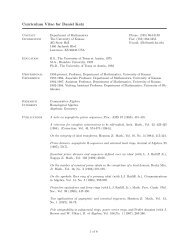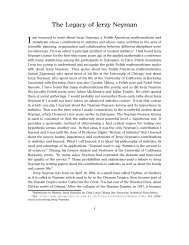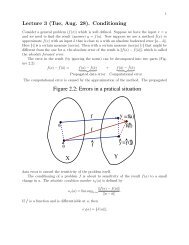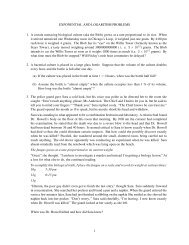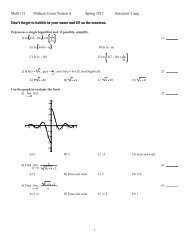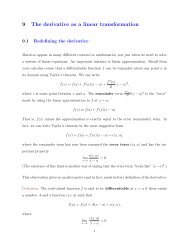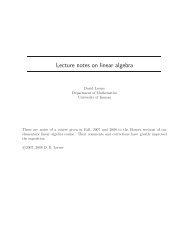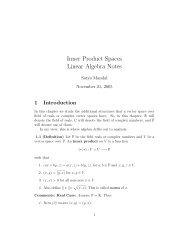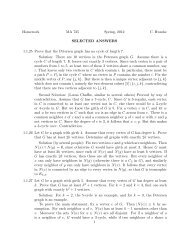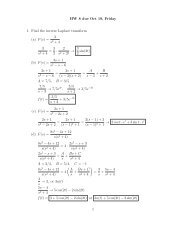Canonical Forms Linear Algebra Notes
Canonical Forms Linear Algebra Notes
Canonical Forms Linear Algebra Notes
Create successful ePaper yourself
Turn your PDF publications into a flip-book with our unique Google optimized e-Paper software.
2. Now let V be a vector space over F with dim V = n < ∞. A<br />
linear operator T : V → V is said to be triangulable, if there<br />
is a basis E = {e1, . . . , en} of V such that the matrix of V is<br />
an (upper) triangular matrix. (Note that it does not make a<br />
difference if we say ”upper” or ”lower” trinagular. To avoid<br />
confusion, we will assume upper triangular.)<br />
3. Now suppose a linear operator T is triangulable. So, for a basis<br />
E = {e1, . . . , en} we have (T (e1), . . . , T (en)) = (e1, . . . , en)A<br />
for some triangular matrix A = (aij). We assume that A is<br />
upper triangular. For 1 ≤ r ≤ n, write Wr = span(e1, . . . , er).<br />
Then Wr is invariant under T.<br />
4. (Factorization.) Suppose T ∈ L(V, V ) is triangulable. So,<br />
the matrix of T, with respect to a basis e1, . . . , en, is an upper<br />
triangular matrix A = (aij). Note that the characterictic<br />
polynomial q of T is given by<br />
q(X) = det(IX − A) = (X − a11)(X − a22) · · · (X − ann).<br />
Therefore, q is completely factorizable. So, we have<br />
q(X) = (X − c1) d1 (X − c2) d2 · · · (X − ck) dk .<br />
where d1 + d2 + · · · + dk = dim V and c1, . . . , ck are the distinct<br />
eigen values of T.<br />
Also, since the minimal monic polynomial p of T divides q, it<br />
follows that p is also completely factorizable. Therefore,<br />
p(X) = (X − c1) r1 (X − c2) r2 · · · (X − ck) rk .<br />
where ri ≤ di for i = 1, . . . , k.<br />
4.6 (Theorem) Let V be a vector space over F with with finite<br />
dimension dim V = n and T : V → V be a linear operator on V.<br />
Then T is triangulable if and only if the minimal polynomial p of T<br />
is a product of linear factors.<br />
Proof. (⇒): We have already shown in (4) of Remark 4.5, that if<br />
T is triangulable then the MMP p factors into linear factors.<br />
16





